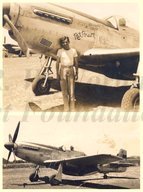
|

|
|
|
|
James was born in Rochester, Texas, a small town north of Abilene. He remembers his father, Hubert Lincoln Guffey, a cotton gin worker, as being talented in all kinds of mechanical tasks from "work on the smallest wristwatch to the biggest locomotive." James worked in cotton too--picking, hoeing, and dusting it with an airplane. When his father died suddenly in 1940, James quit school to help make a living for his mother and two sisters. He enlisted on October 23, 1942, joining the U.S. Army Air Forces. "I always had a horror of a bayonet," is the wry reason he gives for joining the air forces. Also, he says, "I wanted to fly more than anything I'd ever wanted in my life." He entered flight training at San Antonio Aviation Cadet Center in April of 1943. He reported to Coffeyville, Kansas, for basic flight training, then to Foster Field in Victoria, Texas for advanced training. There he earned his wings on February 8, 1944. He trained in P-39s and P-63s in Maryville and Chico, California, and in P-51s and P-49s at Key Field in Meridian, Mississippi. Ordered to Kunming, China, he joined the Sixteenth Fighter Squadron of the Fifty-first Fighter Group. He flew P-40s, then P-51s, but was not often ordered on missions. "We had trouble getting our flight pay," he says. It took him fifteen months to fly twenty missions, which included ship bombing and strafing. On some missions he flew an F-6--a P-51 with cameras, to assess air damage. His call sign was Dopey. He named his airplane, "Rat Poison." James sailed home on the General A.W. Greeley, arriving in New York harbor on December 5, 1945. "Red Cross was there and gave us milk and donuts, the first milk I'd had in fifteen months," he says. James extended his service by a year, and then left in 1947 to become a civilian flight instructor. He was married and divorced, and then wed Ester Ladatta. They had one child. He came to Shreveport in 1960 to work in a flight school. He also crop-dusted for twenty-five years. |


